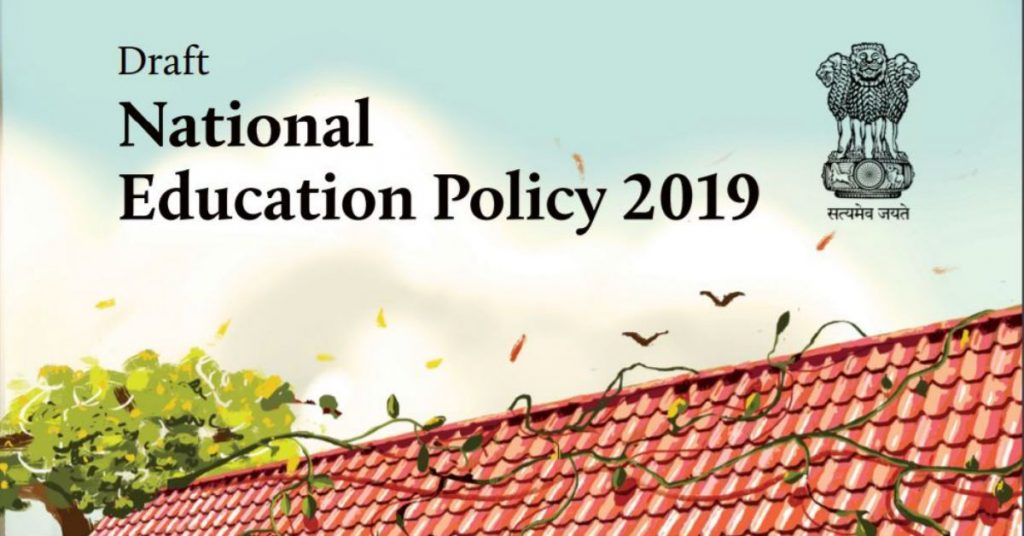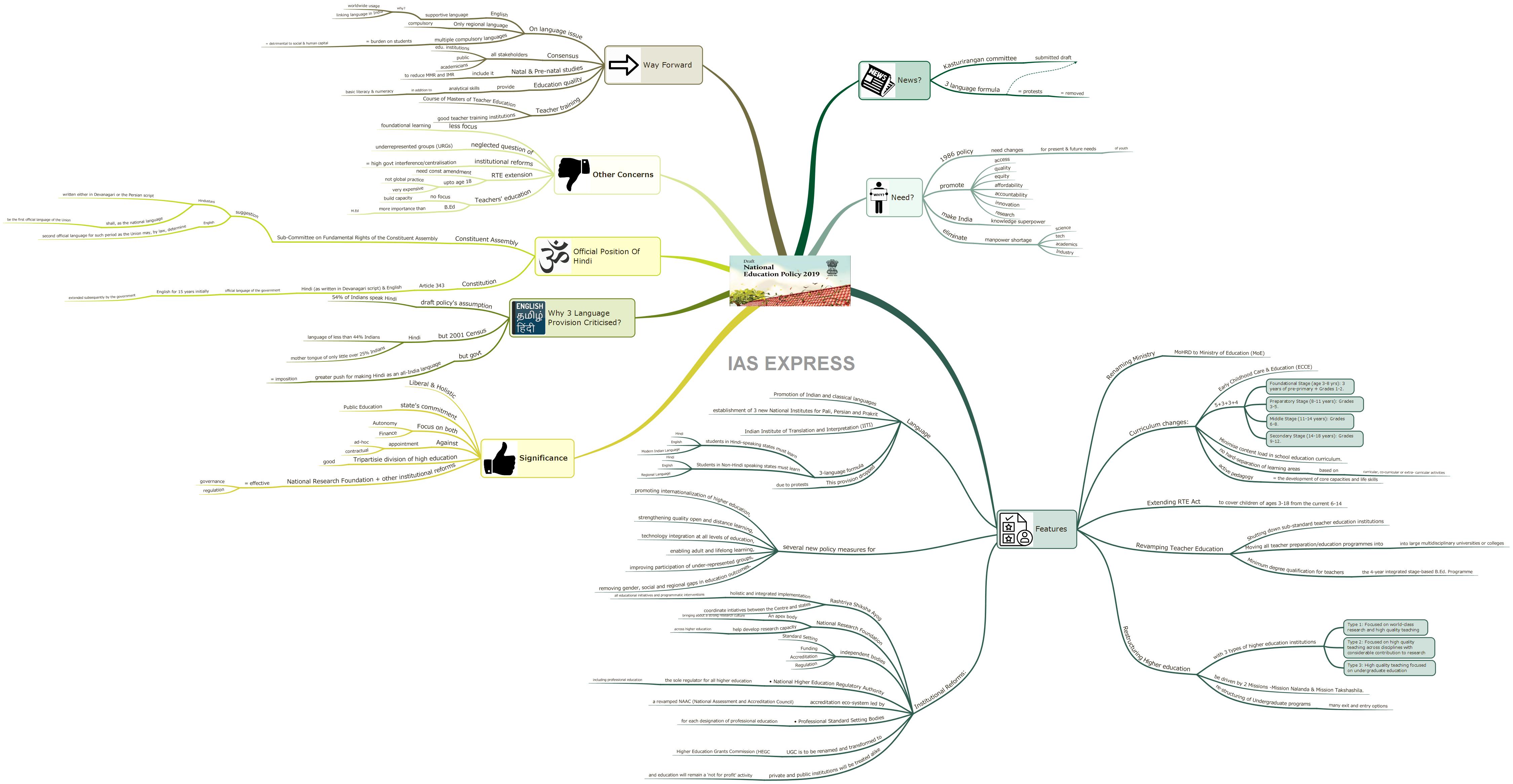[Updated] Draft National Education Policy 2019 – Three Language Controversy

From Current Affairs Notes for UPSC » Editorials & In-depths » This topic
IAS EXPRESS Vs UPSC Prelims 2024: 85+ questions reflected
Updates *
Recently, the draft of the New National Education Policy has been submitted by the Dr. Kasturirangan Committee on Education Policy. The draft has invited criticism and protests due to the provision of three language formula. The controversial provision was hence revised by Dr. Kasturirangan-led committee.
What is the need for/objectives of new education policy?
- The National Education Policy on Education 1986 which was later modified in 1992 needed several changes for present and future needs of India’s large youth population.
- To promote access, quality, equity, affordability and accountability in education.
- To promote innovation and research.
- To make India a knowledge superpower by providing students with the right skills and knowledge.
- To eliminate the shortage of manpower in science, technology, academics, and industry.
What are the salient features of the draft?
Renaming Ministry: Rename Ministry of Human Resource Development as Ministry of Education (MoE).
Curriculum changes:
- Major changes proposed for curriculum and pedagogy in school education.
- Early childhood care and education (ECCE) will be an integral part of school education.
- Introducing 5+3+3+4 curricular and pedagogical structure based on the cognitive and socio-emotional developmental stages of children. It consists of
- Foundational Stage (age 3-8 yrs): 3 years of pre-primary + Grades 1-2.
- Preparatory Stage (8-11 years): Grades 3-5.
- Middle Stage (11-14 years): Grades 6-8.
- Secondary Stage (14-18 years): Grades 9-12.
- Minimise content load in the school education curriculum.
- There will be no hard-separation of learning areas with respect to curricular, co-curricular or extracurricular activities.
- All subjects, including arts, music, crafts, sports, yoga, community service, etc will become a part of the curricula.
- Thus, schools will be re-organized into school complexes.
- Promotes active pedagogy for the development of core capacities and life skills, including 21st-century skills.
Extending RTE Act: Extend Right to Education (RTE) Act 2009 to cover children of ages 3-18 from the current 6-14.
Revamping Teacher Education:
- Proposes massive changes in the teacher education system as follows.
- Shutting down sub-standard teacher education institutions.
- Moving all teacher preparation/education programmes into large multidisciplinary universities or colleges.
- Minimum degree qualification for teachers will be the 4-year integrated stage-based B.Ed. Programme.
Restructuring Higher education:
- Restructuring of higher education institutions is proposed with 3 types of higher education institutions as follows –
- Type 1: Focused on world-class research and high-quality teaching
- Type 2: Focused on high-quality teaching across disciplines with a considerable contribution to research
- Type 3: High-quality teaching focused on undergraduate education
- These institutions will be driven by 2 Missions -Mission Nalanda & Mission Takshashila.
- There will be re-structuring of Undergraduate programs like BSc, BA, BCom, BVoc of 3 or 4 years duration and having many exit and entry options.
Institutional Reforms:
- A new apex body Rashtriya Shiksha Ayog will be created.
- This is to facilitate a holistic and integrated implementation of all educational initiatives and programmatic interventions.
- The body will also coordinate initiatives between the Centre and states.
- The National Research Foundation,
-
- An apex body is proposed for bringing about a strong research culture.
- It will help develop research capacity across higher education.
- The 4 functions of Standard Setting, Funding, Accreditation, and Regulation will be separated and carried out by independent bodies.
- National Higher Education Regulatory Authority will be the sole regulator for all higher education including professional education.
- The policy proposes to create an accreditation eco-system led by a revamped NAAC (National Assessment and Accreditation Council).
- Professional Standard Setting Bodies for each designation of professional education was proposed.
- University Grants Commission (UGC) is to be renamed and transformed to Higher Education Grants Commission (HEGC).
- The private and public institutions will be treated alike, and education will remain a ‘not for profit’ activity.
- In addition to the above, the committee also suggested several new policy measures for –
- promoting the internationalization of higher education,
- strengthening quality open and distance learning,
- technology integration at all levels of education,
- enabling adult and lifelong learning,
- improving the participation of under-represented groups,
- removing gender, social and regional gaps in education outcomes.
Language
- Promotion of Indian and classical languages and establishment of 3 new National Institutes for Pali, Persian, and Prakrit were proposed.
- Indian Institute of Translation and Interpretation (IITI) was also proposed under the policy.
- The policy calls for the effective implementation of the 3-language formula (dating back to 1968) in schools across the country.
- According to the formula, students in Hindi-speaking states must learn a modern Indian language, in addition to Hindi and English.
- In non-Hindi-speaking states, students will have to learn Hindi along with the regional language and English.
- The controversial three language provision was, however, dropped after protests against it in several states.
- The draft was revised by the committee making necessary changes in this regard.
What are the significances of the policy? *
Liberal and holistic: The most significant thing about the policy is the acknowledgment that, “all education is, and should have to be envisioned as, liberal and holistic”.
Public education: There is a strong reiteration of the state’s commitment to public education, much needed at a time when privatisation objective seems to be overriding the social welfare objective of governments.
Autonomy & Finance: Also welcome is the explicit assurance that institutional autonomy is not just a polite term for financial abandonment.
Ad- hoc and contractual appointments: Finally, the acknowledgment that, “the rampant resort to ad hoc and contractual appointments has crippled higher education and should be stopped immediately” will surely bring relief to teachers’ organisations agitating tirelessly on this very issue.
Core Objective: The core objective based on a tripartite division of higher education into teaching universities, research universities, and optimally-sized multi-disciplinary undergraduate colleges is sound.
National Research Foundation: The diagnosis and prescriptions for the important areas of governance and regulation are workable as initial starting points, as is the plan to create a National Research Foundation independent of regulatory bodies.
Why the three language provision was opposed?
- The draft policy’s push for Hindi seems to be based on the assumption that 54% of Indians speak Hindi.
- But according to the 2001 Census, 52 crores out of 121 crore people identified Hindi as their language. About 32 crore people declared Hindi as their mother tongue.
- This means that Hindi is the language of less than 44% Indians and mother tongue of only a little over 25% people in India.
- However, there has been a greater push for making Hindi as an all-India language, which is seen as an imposition of Hindi by many states, especially that of the South.
- If a language is helpful in a person’s life (for example – employment), learning that language is essential. For instance, if a person from Tamil Nadu is employed in a north Indian state, he has no choice but to learn Hindi to survive there without the need to impose it on him. However, forcing him to learn a language which doesn’t provide any benefit to his life is counter-productive, waste of precious time, and violative of his right to personal liberty.
How has the official position of Hindi evolved?
Constituent Assembly:
The debate over Hindi has been continuing since Independence.
- The Constituent Assembly witnessed heated exchanges over the use and scope of Hindi.
- The Sub-Committee on Fundamental Rights of the Constituent Assembly suggested the following:
- Hindustani, written either in Devanagari or the Persian script at the option of the citizen, shall, as the national language, be the first official language of the Union.
- English shall be the second official language for such period as the Union may, by law, determine.
Constitution: Article 343 of the Constitution prescribes Hindi (as written in Devanagari script) as the official language of the government along with English for 15 years initially (but it has been extended subsequently by the government).
- Clearly, the Constitution did not declare Hindi as the ‘national language’.
- It rather provided Hindi with the status of ‘official language’ along with English.
What are the other concerns with the draft? *
Neglected Foundational Learning:
- The policy focusses less on the integration of foundational learning with schooling.
- In Europe, compulsory education only starts at the age of 6. In some countries like Denmark, Germany, and Finland, compulsory education starts at the age of 7.
- Moreover, there needs to be a discussion on whether literacy and numeracy skills should be developed during the time of foundational learning.
Discrimination and Exclusion:
- Neglected the question of Under-Represented Groups (URGs) who are outside school education currently.
- Caste discrimination has long been a serious issue in higher education and has attracted intense public attention in recent years, from Rohith Vemula to Payal Tadavi.
- Furthermore, national statistics show that Persons with Disability and Muslims are by far the leading URGs in higher education.
Governmental interference:
- The proposed institutional framework for higher education clearly reflects even more governmental control with considerable levels of centralization than what is already the case.
Right to Education Extension:
- A constitutional amendment is needed to alter the limits for compulsory schooling in the country.
- Further, extending the limit up to the age of 18 is not consistent with the limits across the world + it is a very expensive move.
Teachers’ Education:
- There is not sufficient capacity in the country to satisfy the needs of teachers’ education.
- Also, M.Ed has been provided less importance under the policy. The focus has been more on B.Ed.
Way forward *
- Language: A language is mainly a utilitarian tool for acquiring knowledge. While learning new languages is indeed beneficial, compulsory learning should be restricted to one’s own mother tongue. Besides, English already provides access to global knowledge as well as serving as a link language within India. So making English a supportive language is indeed a viable option. But making multiple languages compulsory is detrimental to both the social and human capital of the country.
- Consensus: Education is a concurrent list subject. In addition to the consensus between the centre and the states, all the other stakeholders such as educational institutions, public and academicians should also be consulted.
- Natal and prenatal studies: should also be included in the Indian education system to create awareness about the issues regarding the mother and infants, in view of the high Maternal Mortality Rate (MMR) and Infant Mortality Rate (IMR) in the country.
- Education Quality: The quality of education provided in the country should be such that it not only provides basic literacy and numeracy but also creates analytical learning in the country.
- Teacher Training: There should be a course of Masters of Teacher Education. Furthermore, there is a need to establish good teacher training institutions.
If you like this post, please share your feedback in the comments section below so that we will upload more posts like this.



Great Blog!